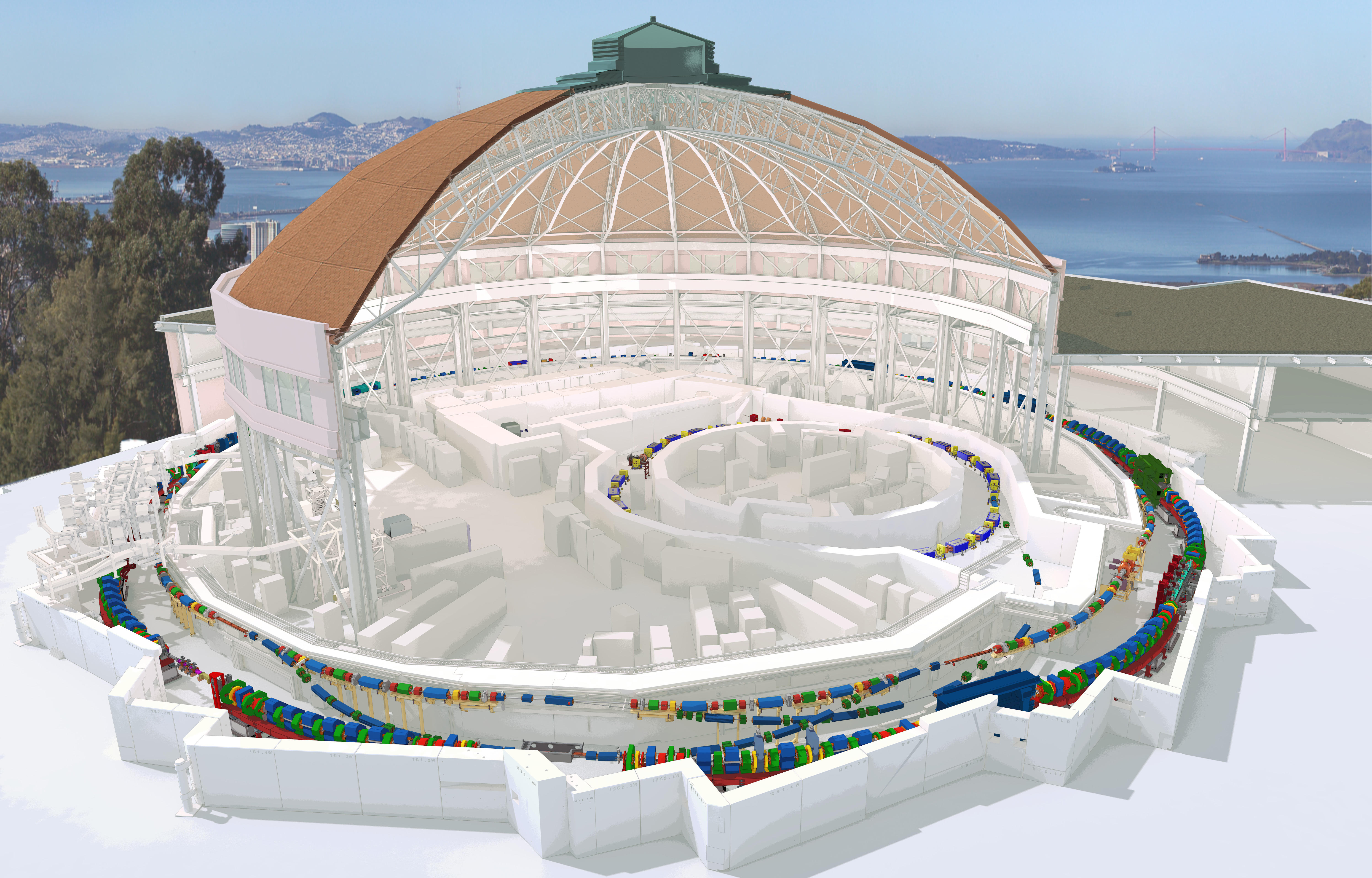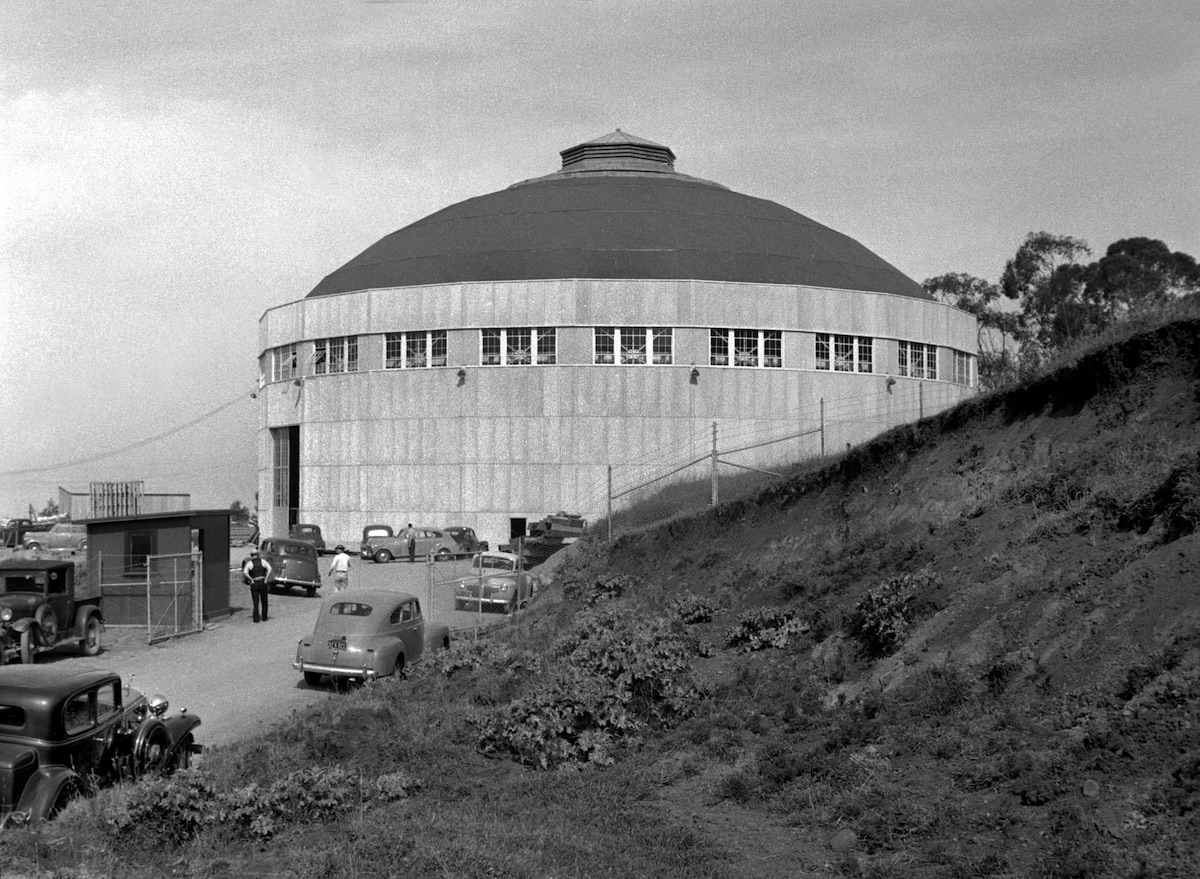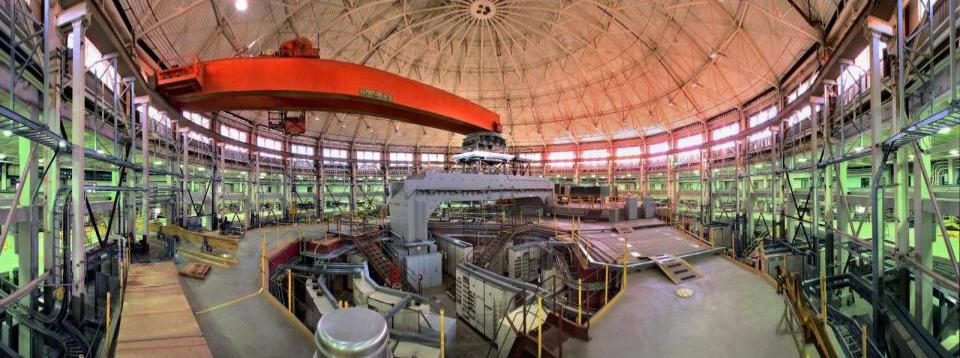VIDEO: Berkeley Lab’s Advanced Light Source takes a next step toward a major upgrade. (Credit: Berkeley Lab)
The Advanced Light Source (ALS), a scientific user facility at the Department of Energy’s (DOE) Lawrence Berkeley National Laboratory (Berkeley Lab), has received federal approval to proceed with preliminary design, planning and R&D work for a major upgrade project that will boost the brightness of its X-ray beams at least a hundredfold.
The upgrade will give the ALS, which this year celebrates its 25th anniversary, brighter beams with a more ordered structure – like evenly spaced ripples in a pond – that will better reveal nanoscale details in complex chemical reactions and in new materials, expanding the envelope for scientific exploration.
“This upgrade will make it possible for Berkeley Lab to be the leader in soft X-ray research for another 25 years, and for the ALS to remain at the center of this Laboratory for that time,” said Berkeley Lab Director Mike Witherell.
Steve Kevan, ALS Director, added, “The upgrade will transform the ALS. It will expand our scientific frontiers, enabling studies of materials and phenomena that are at the edge of our understanding today. And it will renew the ALS’s innovative spirit, attracting the best researchers from around the world to our facility to conduct their experiments in collaboration with our scientists.”

This computer rendering provides a top view of the ALS and shows equipment that will be installed during the ALS-U project. (Credit: Berkeley Lab)
The latest approval by the DOE, known as Critical Decision 1 or CD-1, authorizes the start of engineering and design work to increase the brightness and to more precisely focus the beams of light produced at the ALS that drive a broad range of science experiments. The upgrade project is dubbed ALS-U.
The dozens of beamlines maintained and operated by Berkeley Lab staff and scientists at the ALS conduct experiments simultaneously at all hours, attracting more than 2,000 researchers each year from across the country and around the globe through its role in a network of DOE Office of Science User Facilities.
This upgrade is intended to make the ALS the brightest storage ring-based source of soft X-rays in the world. Soft X-rays have an energy range that is especially useful for observing chemistry in action and for studying a material’s electronic and magnetic properties in microscopic detail.
Click the play button at bottom left to view a slideshow. This slideshow chronicles the history of the Advanced Light Source and the building that houses it, which was formerly home to a 184-inch cyclotron – another type of particle accelerator. It also shows the science conducted at the ALS and includes computer renderings of new equipment that will be installed as a part of the ALS-U project. (Credit: Berkeley Lab)
The planned upgrade will significantly increase the brightness of the ALS by focusing more light on a smaller spot. X-ray beams that today are about 100 microns (4 thousandths of an inch) across – smaller than the diameter of a human hair – will be squeezed down to just a few microns after the upgrade.
“That’s very exciting for us,” said Elke Arenholz, a senior staff scientist at the ALS. The upgrade will imbue the X-rays with a property known as “coherence” that will allow scientists to explore more complex and disordered samples with high precision. The high coherence of the soft X-ray light generated by the ALS-U will approach a theoretical limit.
“We can take materials that are more in their natural state, resolve any fluctuations, and look much more closely at the structure of materials, down to the nanoscale,” Arenholz said.
Among the many applications of these more precise beams are smaller-scale explorations of magnetic properties in multilayer data-storage materials, she said, and new observations of battery chemistry and other reactions as they occur. The upgrade should also enable faster data collection, which can allow researchers to speed up their experiments, she noted.
“We will have a lot of very interesting, new data that we couldn’t acquire before,” she said. Analyzing that data and feeding it back into new experiments will also draw upon other Berkeley Lab capabilities, including sample fabrication, complementary study techniques, and theory work at the Lab’s Molecular Foundry; as well as data processing, simulation and analysis work at the Lab’s National Energy Research Scientific Computing Center (NERSC).
William Chueh, an assistant professor of materials science at Stanford University who also heads up the users’ association for researchers who use the ALS or are interested in using the ALS, said that the upgrade will aid his studies by improving the resolution in tracking how charged particles move through batteries and fuel cells, for example.
“I am very excited by the science that the ALS-U project will enable. Such a tool will provide insights and design rules that help us to develop tomorrow’s materials,” Chueh said.

This cutaway view of the Advanced Light Source shows new equipment (colored rings) that will be installed during the ALS Upgrade project. (Credit: Matthaeus Leitner/Berkeley Lab)
The upgrade project is a massive undertaking that will draw upon most areas at the Lab, said ALS-U Project Director David Robin, requiring the expertise of accelerator physicists, mechanical and electrical engineers, computer scientists, beamline optics and controls specialists, and safety and project management personnel, among a long list.
Berkeley Lab’s pioneering history of innovation and achievements in accelerator science, beginning with Lab founder Ernest Lawrence’s construction of the first cyclotron particle accelerator in 1930, have well-prepared the Lab for this latest project, Robin said.
He noted the historic contribution by the late Klaus Halbach, a Berkeley Lab scientist whose design of compact, powerful magnetic instruments known as permanent magnet insertion devices paved the way for the design of the current ALS and other so-called third-generation light sources of its kind.
The ALS-U project will remove more than 400 tons of equipment associated with the existing ALS storage ring, which is used to circulate electrons at nearly the speed of light to generate the synchrotron radiation that is ultimately emitted as X-rays and other forms of light.
A new magnetic array known as a “multi-bend achromat lattice” will take its place, and a secondary, “accumulator” ring will be added that will enhance beam brightness. Also, several new ALS beamlines are already optimized for the high brightness and coherence of the ALS-U beams, and there are plans for additional beamline upgrades.

This 1940s photograph shows the original building that housed a 184-inch cyclotron and that now contains the ALS. (Credit: Berkeley Lab)
The iconic domed building that houses the ALS – which was designed in the 1930s by Arthur Brown Jr., the architect for San Francisco landmark Coit Tower – will be preserved in the upgrade project. The ALS dome originally housed an accelerator known as the 184-inch cyclotron.
Robin credited the ALS-U project team, with support from all areas of the Lab, in the continuing progress toward the upgrade. “They have done a tremendous job in getting us to the point that we are at today,” he said.
Witherell said, “The fact that we will have this upgraded Advanced Light Source is an enormous vote of confidence in us by the federal government and the taxpayers.”
Berkeley Lab’s ALS, Molecular Foundry, and NERSC are all DOE Office of Science user facilities.
More information:
- ALS-U Overview
- Transformational X-ray Project Takes a Step Forward, Oct. 3, 2016
- A Brief History of the ALS
###
Lawrence Berkeley National Laboratory addresses the world’s most urgent scientific challenges by advancing sustainable energy, protecting human health, creating new materials, and revealing the origin and fate of the universe. Founded in 1931, Berkeley Lab’s scientific expertise has been recognized with 13 Nobel Prizes. The University of California manages Berkeley Lab for the U.S. Department of Energy’s Office of Science. For more, visit www.lbl.gov.
DOE’s Office of Science is the single largest supporter of basic research in the physical sciences in the United States, and is working to address some of the most pressing challenges of our time. For more information, please visit the Office of Science website at science.energy.gov.
